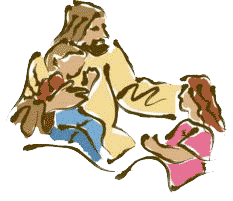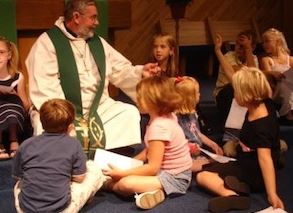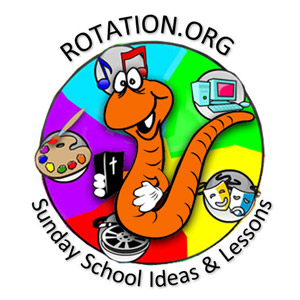Here are two articles about "Better Children's Sermons" that I originally wrote for Church Communication Resources magazine (now defunct) and used to teach at local training events. I've updated them a couple of times over at my software website and decided to archive them here at rotation.org. I hope you find them helpful.
and
7 Tips for Better Children's Sermons
Two articles by (Rev.) Neil MacQueen
Better Children's Sermons
Heard any good children’s sermons lately? Me either.
We’ve been attending a new church and of the five different staff people we’ve heard deliver the children's sermon, only the retired youth minister did a good one (personable, simple, fun, on point). The children's sermons from the pastors, the current youth director, and the new Christian educator made me wince.
I do a couple of things pretty well, and one of them is children’s sermons. I didn’t start out doing them well. Instead, I learned and had some great examples to follow over the years. It isn’t hard to do good children’s sermons if your heart is in it, you take the time to prepare, you know how to relate to children, and you know what not to do. Part of the problem is that there is no training for delivering children's sermons, and church staff rarely if ever get good feedback or pointers on how to improve from people who do children's sermons. I hope this article helps fill some of that need.
Children’s Sermons Problems that I Regularly See
 Concepts and Vocab over the kids’ heads. (Avg age of the kids in front of you is 5, not 12).
Concepts and Vocab over the kids’ heads. (Avg age of the kids in front of you is 5, not 12).- Fuzzy main point often delivered at the very end, or worse –during the “summary” prayer.
- Moralistic rather than Biblical. (Faith is more than “be good.”)
- Too long and convoluted. (Need to K.I.S.S.)
- Boring or poorly selected props. (a rock is a poor metaphor for God to use with children no matter how many scriptures use it).
- Not interactive. (Kids sit, pastor asks question, adults laugh at answer, pastor provides answer.)
- The leader's bland, unenergetic delivery. (Videotape can help them realize this.)
Update: And now I’ve seen a bunch of them delivered “online” during the COVID pandemic. Seen quite a few where the children's sermon deliverer sits by themselves on the Chancel steps and "reads" their comments while trying to look at the camera too.

Kidding aside, most online children's sermons feature a "talking head." In one church I used to attend, during their online services (due to COVID) the pastor sat alone on the chancel steps with a microphone while the camera showed the great emptiness around them. A better option is to create a "demonstration" with props at a table and roll that onscreen for the children's sermon, or pre-tape it, etc.
Why Poor Children's Sermons Persist
- Many pastors think up their Children’s Sermons on Sunday morning, and it shows.
- Many pastors are playing to the adults, or have forgotten how to talk to young children.
- Many non-pastors are often too nervous and forget what and how they were going to say something. They get tongue-tied.
- Most church members have low standards for Children’s Sermons, and thus, they don’t offer constructive feedback.
- Many children’s sermoners act like a “rock” instead of a rock star in front of kids (and adults).
- Most pastors rarely see other pastor's children's sermons, let alone get training. They have nothing to compare theirs to except maybe someone on staff.
Summary of Solutions
 1. Be “Children first,” and “sermon” second. Embody the embrace and spirit of God.
1. Be “Children first,” and “sermon” second. Embody the embrace and spirit of God.
2. Use developmentally appropriate language and illustrations
3. Keep it Simple and Short.
4. Tell stories
5. Use props to illustrate your point. Keep metaphors simple.
6. Make sure your content is God-centered
7. Don’t be a slave to the adult scripture reading. Kids often have different subject needs.
8. Have fun and be a kid yourself. You don't have to always be serious with kids to talk about serious things.
9. Get or ask for training. Browse YouTube to see how other pastors are delivering children's sermons (good and bad)
10. Videotape and review your church's children's sermons. Make them part of your staff discussion. Talk to teachers who have a great presence with children
Some pastors and members think Children’s Sermons are out of date.
They couldn’t be any more wrong.
- (Good) Children’s sermons are an enormous opportunity to help children (and their parents) feel welcome in worship.
- (Good) Children’s sermons are a tremendous opportunity for visitors and members to enjoy the pastor’s away-from-the-pulpit personality and sense of self.
- (Good) Children’s sermons are an important opportunity to share the Gospel with children who won’t be going to Sunday School.
- (Good) Children’s sermons build the pastor’s credibility and reputation among the adults and parents. (Poor ones make you look out of touch.)
- Jesus welcomed children and said their wide-eyed, child-like quality was the gold-standard in the Kingdom of Heaven (Matthew 19:14). Your participation with them in worship is not only a blessing with lifelong consequences for them, -but can be a blessing to your spiritual journey and that of your members’.
Confession: I wish I could go back and tell “young pastor Neil” all this. It took me a few years to “get it”, and when I did, my children’s sermons started shining. I also wish I could hand this article to every pastor I’ve worked with!
7 Tips for Better Children's Sermons
This second article has some more specific helps. It was originally published over at my software website after I presented it at a training day event in my Presbytery some years ago.
1. “Children First”
 When you invite the children, focus on THEM and make them feel invited!
When you invite the children, focus on THEM and make them feel invited!
- Make eye-contact, and greet them as they arrive. (It bothers me to see some pastors ignore the kids as they arrive.)
- Wait for the late-arrivers. Don’t be in a hurry.
- Interact with individuals as they arrive, saying things like “I like your shirt”, etc.
In other words, “welcome the children.” This will help YOU settle down too.
Share something about yourself. And smile! Some children have a fear of being in front of others, especially when there’s an unfamiliar adult up there.
If you are the pastor or large/older adult, be aware of how some children may perceive you based on your appearance. A parent once told me that her daughter was scared of “the man in the black robe”… which just happened to be me. Funny thing was, she was the playmate of one of my kids and knew me well outside of worship. But that black robe scared her. I solved the problem by paying attention to those who seemed a little bit intimidated about coming up front, and immediately involving them. With young children, this can be as simple as letting them hold your prop.
Take time to ask questions, and deal tenderly with their responses. For example, when asking a question to which a child has eagerly raised their hand but not gotten the ‘right’ answer, don’t just say, “no” and move on to the next hand. Take a moment to affirm the child. After the children’s sermon is over, give out a few high-fives, and make a point to acknowledge the kids in the cookie line after church.
2. Be Developmentally Appropriate
 If any of your words have more than 3 syllables, then your words probably won’t be understood. If you’re not good at speaking to children at their level, write out your children’s sermon -then simplify your vocabulary, grammar, and concepts in writing. Many church words are tough for children mostly because they are new and have little experience to understand them. When you use words like “grace,” take a moment to define it.
If any of your words have more than 3 syllables, then your words probably won’t be understood. If you’re not good at speaking to children at their level, write out your children’s sermon -then simplify your vocabulary, grammar, and concepts in writing. Many church words are tough for children mostly because they are new and have little experience to understand them. When you use words like “grace,” take a moment to define it.
Avoid developmentally inappropriate comparisons, such as, “God is like a rock” unless you’re going to take the time to really explain the metaphor. If you don’t, then that rock will just be a rock and they’ll wonder “how heavy and hard is God.”
A lot of wasted time and opportunity has been disguised as OVERLY-clever object-lessons and demonstrations. Some demonstrations are too elaborate or off-point, and end up being really fun distractions. Using a magic trick to make a coin disappear and then saying to a child that, “God makes sin disappear too” –is a fun demonstration that your youngest kids will not fully understand. And does God make sin disappear? Pretty high concept for a 2nd grader. AGAIN… if you are going to “go there” then please spend some TIME there! Many pastors just do things and blow by the meaning.
One church where I worshiped had a “children’s song” projected on the wall for the kids after the children’s sermon. Problem was, half the kids couldn’t read the words. Duh.
PS: Keep your closing prayer developmentally appropriate too. I.E. Drop the Holy Joe vocab.
3. Keep it Simple
Many pastors I’ve seen doing children’s sermons don’t know when to shut up. The more they pile on, the less the kids are likely to remember, and the greater the likelihood the pastor will wander around the subject. Practice this discipline: write out your children’s sermon and then summarize it in one sentence. (I knew a pastor who was so afraid of forgetting his summary sentence that he taped it to the top inside of the paper bag he always brought with him to hold his props. His name was me.)
If you can’t summarize your children’s sermon in 10 seconds or 20 words, then you probably can’t get it right in 3 minutes either.
The corollary of Keep It Simple is: Take your Time and Don’t Rush.
4. Tell stories.
…and stories about YOURSELF are always welcome!
If you want to describe faith or forgiveness, tell a story about it. Stories stick in the brain and the story can continue to teach its meaning after you’re gone. And practically speaking, storytelling grabs their attention quicker, keeps it longer, and stories keep you from groping for what to say next. See #6 and 7 for more about this.
Make sure your stories are kid-friendly. Instead of a story about a man who went to work with his briefcase, tell a story about a boy who went to school with his bookbag. Note: you can make up your own stories! But… if the day’s scripture has a story in it, re-tell it, and by all means USE PROPS.
Note: Remember to have a POINT. So many times you hear a volunteer or pastor tell a story and botch the point of the story. Write it own concisely in kid-friendly concepts and vocabulary. Take it out and read it if you have to. It’s that important.
5. Use props.
Props are not only FUN, they FOCUS attention and create anticipation. Their eyes will even track the prop as you move it. Props also put the storyteller at ease too. But remember, a rock is just a rock to a 5 year old. They can’t quite understand that it is “the weight of sin weighing us down” unless you SLOW DOWN and take the time to explain it (which few pastors do).
Prop Suggestions:
If you’re telling a story about when you were a little boy, bring a ballcap and toy. Involve the kids in your story by assigning roles and distributing props. For example, if you’re telling the story of the man let down through the roof, have one of the kids lay down on a blanket and put a bandage around their leg. Assign someone to be Jesus. And when it gets time to “lower” the man through the roof, you grab the blanket by the boy’s head (for safety) and let the kids grab the rest of the blanket and drag him a few feet towards Jesus. If you are telling the story of Moses talking to God on Mt. Sinai, throw a GIANT robe over the smallest girl and have her be Moses. If you’re telling the story of the disciples in the boat, have your oldest child lay down on a pillow you brought (and tell them not to wake up until you specifically ask them to) and during the story cue all the kids to shout “wake up Jesus.” And when it comes time for the waves to crash over the boat, don’t forget to sprinkle a little bit of water out of the squirt bottle you’ve secretly brought.
The secret to many successful storytellers and children’s sermon presenters is their props. Over the months and years, I would vary my delivery. But often I would bring a big brown bag that had story props in it. What I learned was that the kids eagerly awaited what I had in the bag. It focused their attention. And the props helped them remember my lesson.
Pass your props around! One Sunday, I retold the story of Jesus and the 10 Lepers pulling 10 Barbie Dolls out of my brown bag (Ken was Jesus, of course). I made several of the boys hold them– much to the giggles and grimaces of the children. Years later in a Confirmation class, one of my students said it was one of his favorite Bible stories because of that children’s sermon. Props help us remember.
Speaking of props…. YOU are a prop. Your body is a focal point. Don’t stand or sit there stiff. Be animated. Especially with younger children (but also with all of us) our focus naturally goes to whatever moves. It’s a great way to keep their attention, especially when you’re trying to make your point. Props focus them. Your hands and facial expressions and where you move to will focus them too.
6. Make sure your content is God-centered
We’re not there to teach kids to “play nice and help others.” We’re there to teach them how to be like Christ, who played nice and helped others.
Ask this question about your children’s sermon: what is the Gospel in it? …what is the good news about God in it? In my listening experience, the GOD-POINT is one of the things pastors and volunteers MOST OFTEN leave out, or leave for the last moment of their children’s sermon, or express in the most confusing way. It happens because they run out of time, or didn’t think of the ‘point’ ahead of time.
One of the ways I’ve “cured” myself of this teaching faux pas is to tell the kids the God-Point FIRST, right at the beginning of my children’s sermon or Sunday School lesson (try it, it works!) and then again at the conclusion (and often several times in-between!).
The best way to make SURE that you’re God-centered is to always base your children sermon on a scripture that you want to share, –even if it isn’t the same scripture the adults will be learning. The discipline of always basing your children’s sermon on one of the day’s Bible passages will also take the guesswork out of planning “what to teach” and help you avoid children’s sermons like “God is like this coat hanger which I just grabbed from the back of the church because I didn’t have plan of what I was going to say.”
7. Don’t be a slave to the adult scripture reading
Focusing on “today’s story” is a great way to stay biblical and not just grab for anything. But there are many times and subjects that are appropriate for the pastor to teach the children which do not match the adults’ scripture reading.
“Other” Children’s Sermon subjects include:
-Communion
-Mission
-Baptism
-Caring for friends
-Honoring your mom and dad
-Telling the Truth
-A current event in the community everyone is aware of
-Something special going on in the congregation
-What the candles are for? Whose table is this? Who is welcome up here?
And let’s be honest, NOT all scripture is suitable for children. If your adult sermon is about Lamentations, you may want to simplify it for the kids, or substitute any story.
MISC THOUGHTS:
Sit or Stand?
The answer depends on what you’re doing in your children’s sermon. Sometimes I stand and then sit. Sometimes I sit, then get up to do something. Standing and moving helps those who need something to track, but I can also get their attention sitting down if I have a prop and move while sitting. The other answer is this: you don’t stand just so the adults can see you. “Children first,” remember?
Microphone?
Handheld microphones are a crutch that get in the way of children’s sermons, and never belong in a child’s face. invest in a headset or lapel mike, and make it a habit to repeat what the children say.
Is the Children’s Sermon for the Adults Too?
Yes…actually IT IS FOR THEM TOO ! ….but only if you do it well enough to be good for both audiences. Many adults, me included, will judge you poorly if you shoot the message over the kids’ heads in an obvious attempt to speak to the adults. The best messages are ones you “overhear” …and then suddenly realize the speaker is speaking to you as well.
At what age should they stop coming forward?
Time was when ALL the elementary age children came forward, and even some young teens. In the past decade, however, I’ve noticed the average age getting younger and younger. This has a lot to do with who your kids are and your church demographics, but it may also be a reflection of the “age” of your children’s sermons. Some pastors aim young, and that sends a signal to the older kids.
Ideally, I think kids will naturally start to stay in the pew around age 11. If an older child reluctantly comes forward, give them some special roles.
Neil MacQueen is a Presbyterian minister, veteran of “the steps upfront,” children and youth ministry pastor, writer and consultant, developer of interactive Bible software for children and youth, and writer of creative curriculum for Rotation.org.

 Children in Worship
Children in Worship

















